Nylon demand healthy in the off-season of 2021
Coming to the end of June, The traditional off-season is about to pass halfway, but some sectors of the nylon filament market have never been like in off-season. The average operating rate of nylon 6 textile filament plants has been kept as high as 87%, close to 90%, and there are so far no any scaled-plants have turnaround plans. But of course, the off-season characteristics of some nylon filaments are quite obvious, as their inventory has been accumulated high still. In a word, nylon 6 filament plants have maintained a high inventory and high operating rate still. What is this situation compared to other fibers?
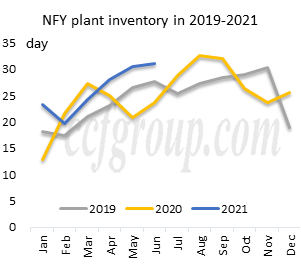
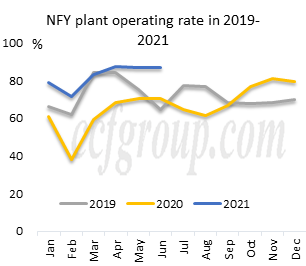
Nylon filament sales/production balanced, supported by dull products
The inventory of nylon filament was still growing in June, but slower than the previous month. Inventory accumulated was controlled mainly by two facts. First, some semi-dull nylon 6 high-speed-spinning chip plants had switched their production to dull chips, and thus expanded the supply of previously tight supply. Some filament plants had adjusted their production accordingly, to meet the robust demand for dull filament. Second, some filament plants altered product to fine-denier filament, and thus lubricated the general sales condition of NFY market. These methods helped NFY producers to roughly balance their high production and sales in the traditional off-season.
Polyester plants still running at high, inventory under control
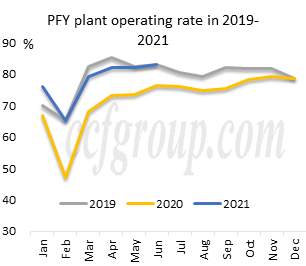
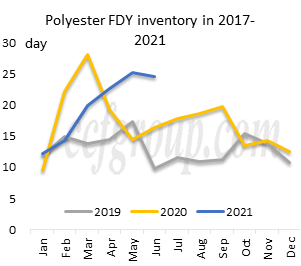
Polyester filament plant operating rate was basically in line with its run rate in the same period of 2019, but its inventory rate was higher than that in 2019 (here only FDY inventory is taken as example, and in fact, POY and DTY stock are in similar condition), but similar with that in 2020.
But similar with nylon filament, polyester filament plants did not cut their run rate during May-June, while could balance inventory accumulated in June. The main reason is that the staged sales promotion effect of polyester filament was good, and there was a relatively more regular purchasing cycle. This also shows that although downstream rigid demand in the price-sensitive off-season was not too bad, and it had basically meet the supply.
Viscose and spandex are two extremes
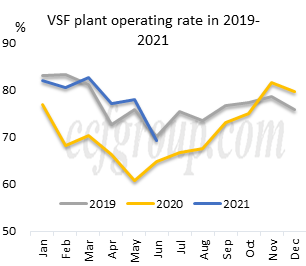
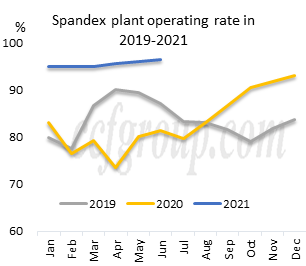
Of all textile raw materials, viscose and spandex are two extremes. The run rate of viscose plants had dropped evidently in June, and this was related with a stronger risk aversion in viscose plants, who had suffered fierce fluctuations over the past years. Viscose plants and downstream buyers were more cautious and more conservative when prices were in downward trend. In the high stock and low profit status, viscose plants had cut down operating rate evidently.
Spandex had grown to a recent hot topic in the past year, though it was just an “auxiliary material” before. The demand in China domestic market and around the world had surged significantly in the past two years and prices and profit had multiplied. Even when spandex plants were almost running at their highest rate, supply was still tight in the traditional off-season, a proof to the extremely good demand.
Apart from the three above-mentioned products, the performance of other mainstream chemical fibers in June was not bad compared with the same period in the past two years. And nylon was slightly better than its performance in the same period in 2019. And to put them together, nylon is slightly better than polyester while not as good as acrylic.
Nylon downstream looms better than average
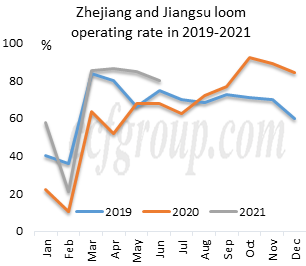
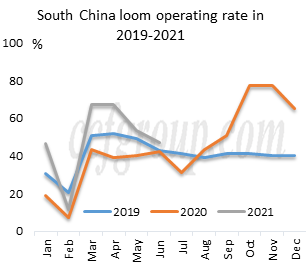
Seen from the production situation of downstream fabric mills, the overall operation in East China and South China decreased in June, which was in line with the traditional off-season trend. Among them, the production reduction in East China was mainly related with the run rate of Wujiang water jet loom, which gradually dropped from 90% in May to 70% in June. However, the operating rate of nylon-related fabric mills was relatively stable (such as 380T). The consumption has not been significantly reduced. In South China, the run rate of circular knitting machines in Guangdong dropped the most. It was first affected by weaker demand and also influenced by phased production and power restrictions. However, for nylon, the double knitting field was still relatively stable, and production was not much influenced. Therefore, in general, although the weaving and knitting market had cut production in the off-season, the situation in downstream areas of nylon was better than the average level.
In summary, in the case of sales and production in June, nylon filament market was better than that in the same period of 2019, though downstream demand had seasonally fell. Compared with other mainstream chemical and synthetic fibers, the situation of nylon could not be described as bad. As the production cut in most sectors of textile industry going in for about 2 months, nylon filament plants are still running stably and have no plan to cut production in short. The stable production status is already proving that demand for nylon is still in good shape.
- Top keywords
- Cotton Price
- Cotton Futures Price
- Cotton Futures
- CZCE
- PTA Futures Price
- Chemical Fiber
- Polyester Prices
- Wool price
- PTA Futures
- Shengze Silk
- China
- Yarn Price
- price
- China Textile City
- Fibre Price
- Benzene Price
- Cotton
- Index
- Cotton Index
- PTA
- fabric price
- NYMEX
- Top 10
- textile industry
- Spot Cotton
- Cotton Yarn
- Polyester Price
- Futures
- PTA Price
- cotton yarn price

